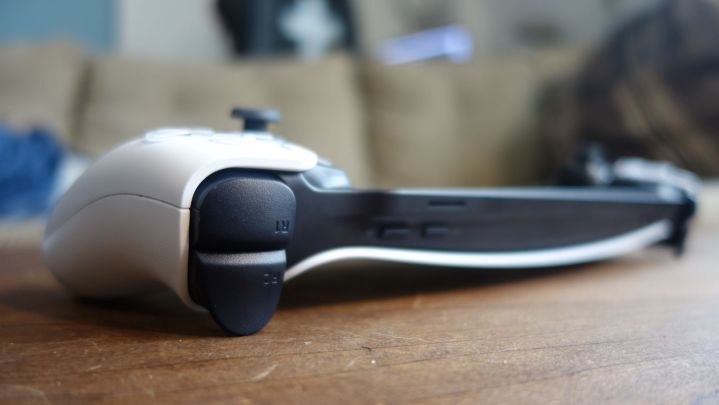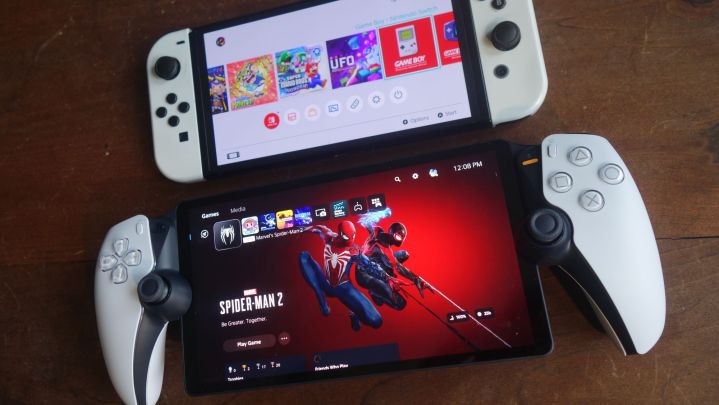
“The PlayStation Portal cuts a whole lot of corners to achieve its low price tag.”
- Low price
- Light and comfortable
- Solid display
- Full DualSense features
- Awkward touch implementation
- No Bluetooth support
- Can't hook up external devices
- Absent settings
What you see is what you get with PlayStation Portal. And it’s not much.
If you were expecting that PlayStation’s standalone Remote Play device would be hiding some hidden secret that Sony was keeping close to the chest, you’ll be sorely disappointed. As pictures have implied, it’s a screen attached to a DualSense controller. It can connect to your PlayStation 5 via Remote Play over Wi-Fi — and that’s all there is to it. If that idea hasn’t already sold you, you can climb down from the fence you’ve been sitting on and get back to gaming on the PS5 from the comfort of your couch.
Though some may find that idea baffling, it most assuredly has its own audience. A device like this is perfect for the kind of PlayStation faithful who uses Remote Play when traveling or just lazing in bed. It’s a much better option than trying to play a PS5 game on a phone, giving players a dedicated screen free of texts or notifications. While the use case is firmly there, Sony doesn’t go too far out of its way to sweeten the niche proposition any further. It’s a first and final offer.
The price is right, but PlayStation Portal does the bare minimum to get its PS5 streaming job done. With no Bluetooth support, absent settings, and questionable design choices, it’s only a serviceable luxury reserved for a very specific kind of PlayStation gamer.
Design and display
Sometimes pictures don’t tell the full story for tech, but they mostly do here. The PlayStation Portal is a PS5 DualSense controller cut right down the middle, with a thin 8-inch LCD display placed right in-between the halves. It’s the same effect you get from strapping a PlayStation Backbone controller onto a phone, except with a much bigger screen and without losing the DualSense grips in the process. It looks a little goofy (it’s not like you’ll be going out in public with it much), but it’s refreshingly comfortable and lightweight at approximately 1.2 pounds.
There are two main draws to buying this at a low $200 rather than just using the devices you already own to accomplish the same thing. The big point is that the controllers here retain every feature the standard DualSense has. You still get haptic feedback and adaptive triggers here, exactly as they work normally. That’s significant, because Sony is notoriously guarded with its controller tech; no third-party devices have those features, including officially licensed ones. Sony gets to claim an exclusive feature here as a result and that gives the Portal an edge.

There’s only one impractical downside to the built-in DualSense design. Any game that uses gyroscopic controls is a bit of a nightmare on the Portal. Try to play Astro’s Playroom and you’ll find yourself shaking the entire device as you try to pull off motion gestures. Your best bet is to disable anything like that in the games you choose to play — or simply skip them altogether on Portal.
The second piece of that is the display, which is a strong selling point. At 8 inches, it’s bigger than the Nintendo Switch OLED and Steam Deck screens. LCD isn’t the most exciting choice, but it’s all you really need considering that you’re always looking at games in reduced quality anyways. The bright, 1080p 60Hz screen makes sure you don’t lose too much more between bouts of standard wireless quality dips.
It’s also a touch display, which only really appears to be a necessity to mimic the DualSense’s touchpad. That implementation is a little awkward, as I need to tap within one of two small boxes on either side of the screen to use them. The low placement under the joysticks means I have to stretch my thumbs quite a bit to hit them. If I tap outside of that space, the screen darkens to call up the Portal’s UI overlay that shows battery status, time, and the settings button (in addition to displaying the touch buttons). Players will need to build up some muscle memory if they want to use touchpad functionality seamlessly in-game.
It feels like the priority here was keeping the final cost as low as possible.
There’s not much else to know about outside of the power, audio pairing, and volume control buttons on the top. The onboard speakers get sufficiently loud too, which is great for playing at home. There’s only one annoyance: The USB-C charging port and headphone jack are both nestled on the underside of the system, tightly pinned right between the back of the screen and an overhanging piece of white plastic. If you happen to have plugs that are a little on the beefy side for whatever reason, you might have trouble fitting them in that narrow slot.
All of this is perfectly fine, but Sony doesn’t try too hard to innovate here — and that could be to its detriment in the long term. There’s no way to detach the screen here like with the Razer Edge, which leaves me wondering what players are supposed to do if they start experiencing DualSense stick drift. The package doesn’t even come with a carrying case of any sort and Sony isn’t currently selling a first-party one you can buy separately. It feels like the priority here was keeping the final cost as low as possible. That’s the right instinct for a product with such a niche use case, but it leaves the Portal feeling a bit too stripped down for its own good.
Streaming and battery
Trying to give a detailed breakdown of “performance” on a device like this is a bit of a fool’s errand. All it can do is stream off a PS5, so your experience will entirely depend on your Wi-Fi speed at any given time. My tests were done over fairly strong New York City Wi-Fi, so my results here may not be that useful to someone in the middle of America. I had a smooth enough time during my tests, though I could feel a slight bit of lag when playing games like Lumines Remastered. It wasn’t enough to ruin the experience by any means, but it was noticeable. I hit some occasional audio hitches and resolution drops too, but nothing out of the ordinary for the tech.
It’s a great way to play PS5 games away from home …
Any problems the device has with streaming are simply issues with Sony’s Remote Play feature. For instance, you can’t use apps like YouTube or Spotify via streaming. If you open either of them, the device lets you know you’re blocked from seeing them and prompts you to go back to the menu. Meanwhile, you can’t cloud stream PS Plus games (such as PS3 titles) through the device. The limitations feel somewhat absurd when encountering them on a $200 device built exclusively for streaming. Thankfully, any future changes to Remote Play should retroactively fix the Portal’s problems.
In my testing, I was able to get about four hours on the dot out of the PlayStation Portal’s battery while streaming and maxing out the speakers. That’s not as impressive as the Logitech Cloud G’s 12-hour life, but it’s enough for a fairly lengthy session. The only oddity here is that there’s no way to see the device’s remaining battery percentage. There’s just a basic three-tick indicator, which briefly goes to zero before the device powers down.

The one disappointment with the entire product is that the Portal doesn’t offer players any flexibility outside of streaming. It doesn’t really have any guts to speak of, and there’s only a very simple connection interface when Remote Play isn’t active. It’s a great way to play PS5 games away from home, but it pales next to other standalone streaming devices. The Razer Edge, for instance, is actually an Android tablet capable of running mobile games. I can download emulators on that device or, heck, run Remote Play. That makes it far more expensive, but more useful too. I’m not sure that Sony makes the strongest case for a pure Remote Player here, which puts it in the same niche category as something like PlayStation TV.
Features … or the lack of them
The stripped-down nature of the project is most apparent in the device’s lack of features. Some of those seem like cost-cutting measures that come with downsides that aren’t worth the savings. For instance, the Portal does not feature Bluetooth support. It only features Sony’s PlayStation Link tech via a button, forcing players to buy a new first-party Sony headset or the $200 Pulse Explore earbuds for wireless listening until third-party companies adopt the tech (a standard headphone jack at least supports any wired listening device).
The Portal has a very slim settings menu …
In my tests, I found that there weren’t really any ways to spice the handheld up with any other external devices either. The USB-C port appears to only work for charging. It won’t recognize my plug-and-play Legion Glasses or even another DualSense. It’s a walled garden.
I can understand keeping the tech simple to maintain price, but software omissions are far more puzzling. The Portal has a very slim settings menu that can be accessed at any time by tapping the screen or exiting Remote Play. It includes some basics like a quick disconnect, audio pairing, and brightness slider (it also, somewhat comically, features an airplane mode toggle that renders the entire system useless considering it can’t do anything offline). Beyond that, the settings menu is slim. Users can tweak the light bar and mute button brightness, change the rest mode timer, and change exactly two controller settings.

That last part is a doozy. The regular PS5 interface gives players the option to switch the joysticks around, set press and hold delays, and create custom button assignments for the DualSense. None of that is present in the Portal software, which only lets players tweak vibration and trigger effect intensity. That is compounded by the lack of Bluetooth, which means that players aren’t able to pair other controllers, including accessibility devices, with the Portal. That’s a restrictive decision that’s surprising coming from Sony, which has been a leader in accessible design this generation.
For those who just want a dedicated way to use Remote Play with ease and retain DualSense features, the PlayStation Portal is an easy recommendation at $200. I already know I’ll bring it along on my holiday trip this year in case I want to finish grabbing every Spider-Man 2 trophy in my downtime (well, depending on my parents’ Wi-Fi). It’s just surprising to see how many corners could be cut with such a simple device. You really get what you pay for here, but you might wish you could have ponied up for a bit more.
Editors' Recommendations
- PS5 Pro: news, rumored release date, price, and specs
- Best PS5 SSD deals: Add more storage to your PS5 from $120
- PlayStation 6: release date speculation, price, specs, and more
- PlayStation Portal 2: 8 features we want in Sony’s next-gen handheld
- The PS5 Pro may be coming even sooner than we thought




